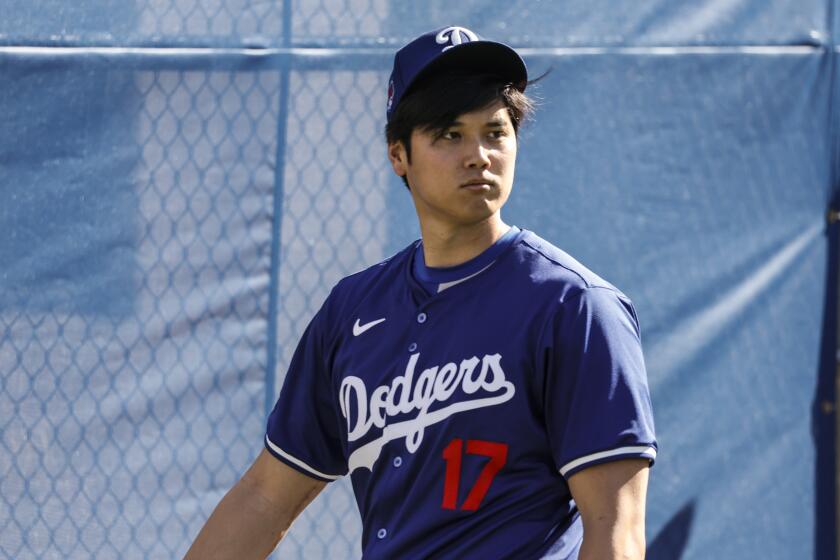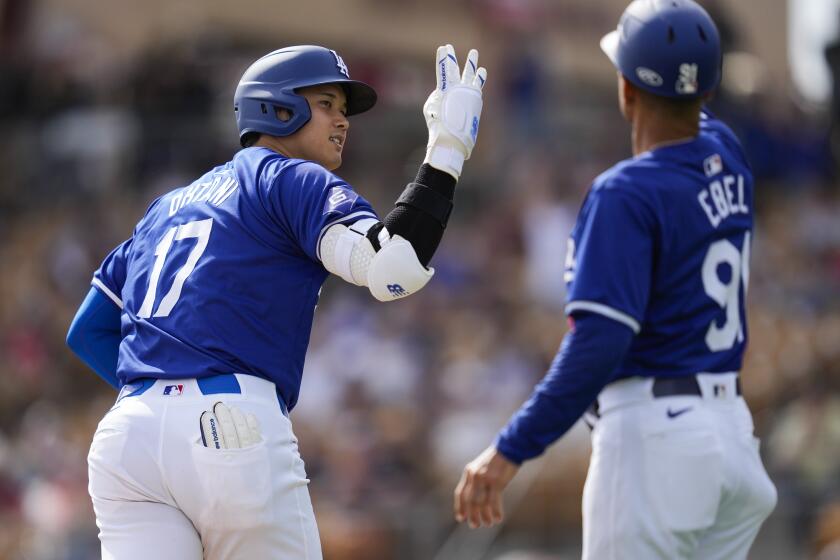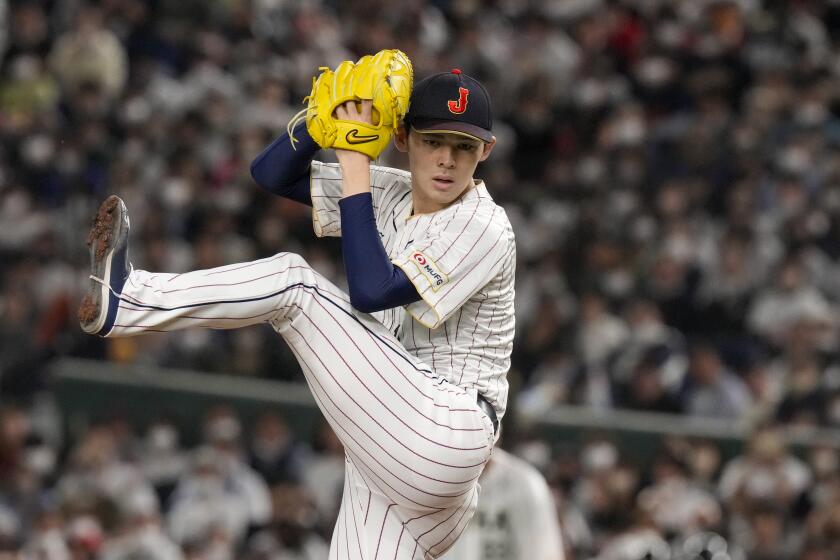‘He’s comfortable.’ Yoshinobu Yamamoto continues Dodgers acclimation with strong spring debut
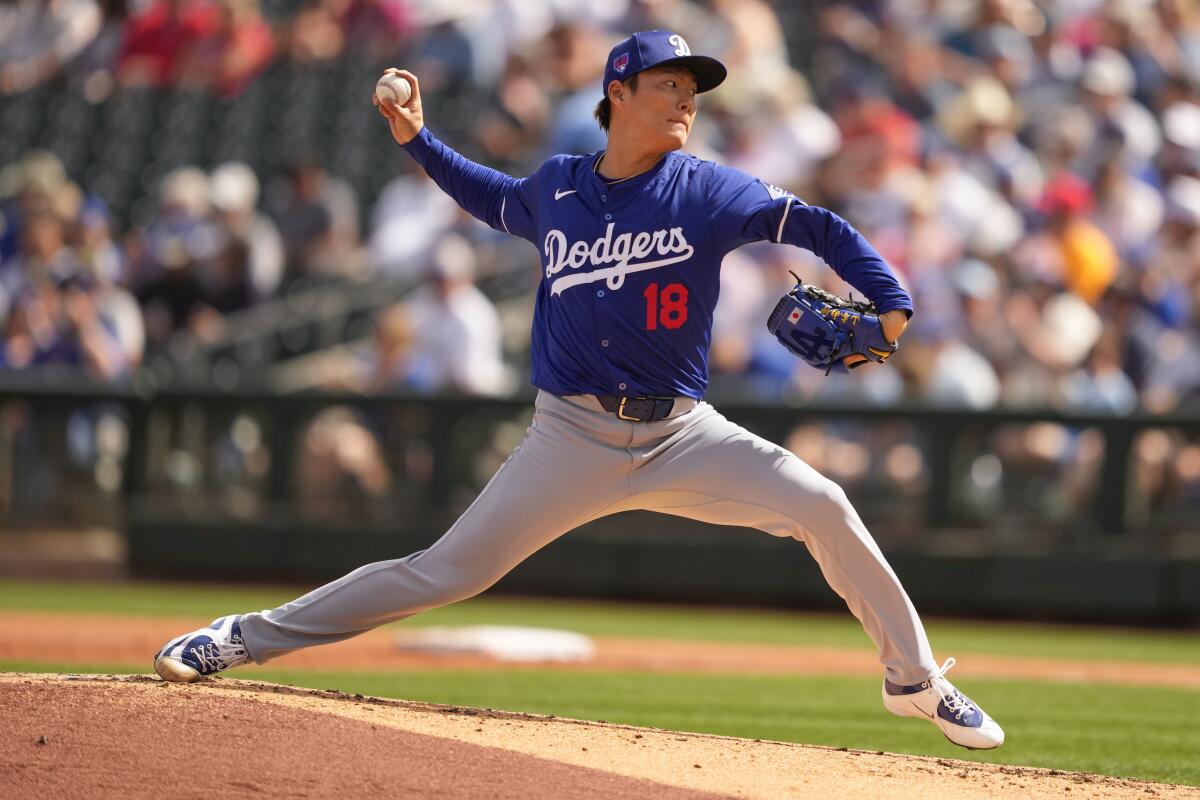
- Share via
PHOENIX — When the Dodgers signed Yoshinobu Yamamoto this offseason, pitching coach Mark Prior knew there would be cultural differences to bridge with the star Japanese right-hander.
It didn’t take long this spring for them to stumble upon even the most mundane examples.
During one of their first conversations at Dodgers camp, as the team planned out Yamamoto’s schedule for the spring, Prior asked his new starter about his routine for “touch and feel” bullpen sessions — brief, low-effort throwing activities mostly meant to keep a pitcher’s delivery in-sync between more extensive full-intensity outings.
“Our version of ‘touch-and-feel’ is like a nice and easy 10-15 [pitches],” Prior said. “Maybe the catcher is even standing up.”
Yamamoto’s interpretation of the drill, on the other hand, was strikingly different.
While the Dodgers’ star is willing to play defense, the team isn’t likely to take him up on the offer, not after he had Tommy John surgery in September.
“His ‘touch-and-feel’ is like [throwing fastballs] 92 mph,” Prior relayed recently with a laugh, noting such velocity is hardly a drop from Yamamoto’s typical mid-90s speed.
“We’ve been understanding the nuances of some of those things,” Prior added. “Making sure we put things into his words.”
Indeed, while Yamamoto has impressed in his bullpens, live batting practice sessions and, on Tuesday, a scoreless two-inning Cactus League debut against the Texas Rangers, it’s the comfort and chemistry that the $325 million pitcher is developing with Dodgers personnel that have been among the biggest developments for the team this spring.
Club staff have marveled at Yamamoto’s unique pitching style and training regime.
Coaches and teammates have praised his combination of command and raw stuff.
And though it’s too early to know exactly how smooth Yamamoto’s MLB transition will go this season — when he will have to handle new hitters, a new schedule and even a new, less tacky MLB ball compared to what he used in Japan — his ability to adapt behind-the-scenes is already standing out to his new team.
“There’s just got to be a relationship,” manager Dave Roberts said. “I think we’ve already begun it, and it’s off to a really good start.”
Yamamoto’s Cactus League campaign got off to an equally auspicious beginning Wednesday.
Facing several regulars from the defending World Series champion Rangers, Yamamoto retired five of the six batters he faced (and negated a lone first-inning single by quickly dialing up an inning-ending double play).
He managed 95 to 96 mph with his fastball, including one heater that fanned All-Star infielder Marcus Semien.
He mixed in a wicked combination of Frisbee-like curveballs, hard-biting cutters and late-breaking splitters, including another strikeout that ended with a flailing half-swing from veteran Nathaniel Lowe.
Perhaps most important, he expressed a feeling of relief after pitching in his first official MLB game.
“I was able to calm down and pitch,” Yamamoto said. “I think it was good that I was able to get through it.”
Added Roberts: “I don’t think it could have went any better.”
The Dodgers’ hope is for Yamamoto’s dominance to translate in the regular season.
In order to get there, they want the 25-year-old to be as adjusted as possible to his new surroundings by the time they break camp.
“The atmosphere on the team is really good,” Yamamoto said in Japanese. “I’m in my first year and everyone is supporting me so that I can integrate into the team. Everyone has been very nice and because of that, I’m able to relax, starting in practice. I think that’s the best part right now.”
After spending the first seven years of his career in Japan’s Nippon Professional Baseball league, where he was a three-time MVP and pitcher of the year, much of Yamamoto’s day-to-day routine differs significantly from his MLB-bred counterparts.
One day this spring, while other Dodger pitchers went through a morning warm-up of stretches and plyo-ball tosses at an open field at Camelback Ranch, Yamamoto found an open patch of grass and began throwing some of his training javelins — 2-foot-long plastic spears with Nerf-like tail fins on the end.
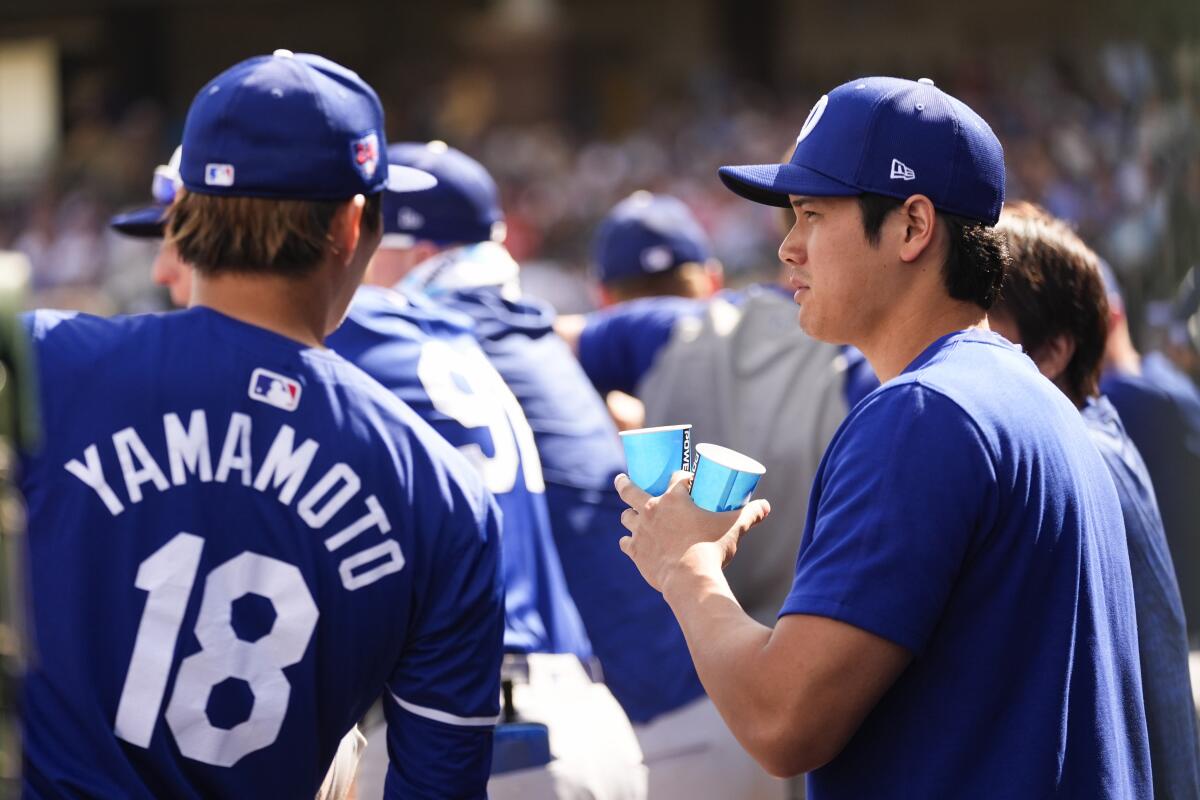
Another afternoon, with the rest of the team gathered around him on one of the club’s backfields, Yamamoto went through a set of sprints that elicited cheers and laughter from his teammates.
“I don’t think it’s out of the norm for a lot of Japanese pitchers who come over here,” Prior said. “That’s the way he has trained for years. So by no means are we going to try to change that. That would be foolish on our part. So it’s more about trying to have an understanding.”
In the clubhouse, Yamamoto is making other inroads.
Despite the language barrier, he has found ways to joke around with Roberts and other players.
“When you see Yoshi walk around, he’s very focused on his work,” Roberts said. “But he’s also smiling when he’s not working. And I think it just shows that he’s comfortable being here.”
Veteran catcher Austin Barnes, who was behind the plate for Yamamoto’s debut Wednesday, echoed similar sentiments.
“I like that guy,” Barnes said with a chuckle recently. “He laughs a lot.”
It also helps that the Dodgers won the winter sweepstakes for fellow Japanese superstar Shohei Ohtani, who didn’t play in Wednesday’s game — his next Cactus League appearance is scheduled for Friday — but still traveled with the team to Surprise Stadium to see Yamamoto’s debut.
“I didn’t think he’d come to watch,” Yamamoto said. “So I thanked him.”
A comical moment between the two occurred at the end of the second inning, when Yamamoto forgot three outs had been recorded until being waved in from Ohtani in the dugout.
Another came when Yamamoto was asked about the evaluation he got from Ohtani for Wednesday’s performance.
“Eh,” Yamamoto said through his interpreter. “So-so.”
Yamamoto graded himself on a strict scale, too, saying he “wasn’t really able to throw the ball to the exact spots that I wanted.”
What started as a slow day for Dodgers star Shohei Ohtani ended with the type of dramatic flair the team hopes to experience often.
If so, it would be one of the few times this spring his command was in any sort of question.
As Roberts noted pregame, Yamamoto’s ability to dot the fastball — and, in turn, set up his wicked secondary weapons — has been the most impressive aspect of the pitcher’s wide-ranging skill set.
“He can go glove side, he can go arm side, he can go down, he can go up,” Roberts said, comparing Yamamoto’s fastball command to that of former Dodgers star Zack Greinke. “For a pitcher to be able to throw the fastball to all the different quadrants, it just opens everything else up.”
The Dodgers’ hope is it will translate in any part of the world, too — especially as Yamamoto adjusts to all the other changes he’ll encounter with a new team, in a new league, in a new country.
“We still have plenty of time to get him ready for the season,” Roberts said. “So right now, it’s just about [having him] going out there and being a pitcher, being a baseball player.”
More to Read
Are you a true-blue fan?
Get our Dodgers Dugout newsletter for insights, news and much more.
You may occasionally receive promotional content from the Los Angeles Times.

